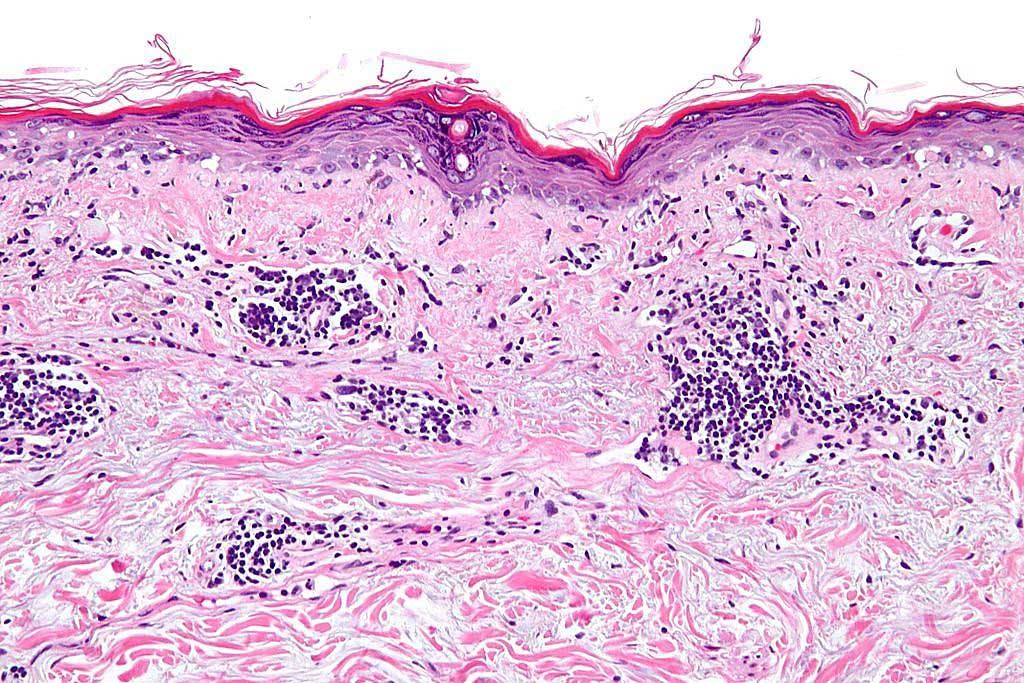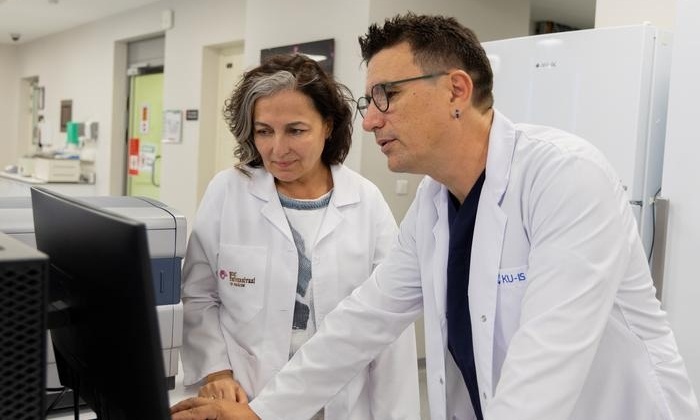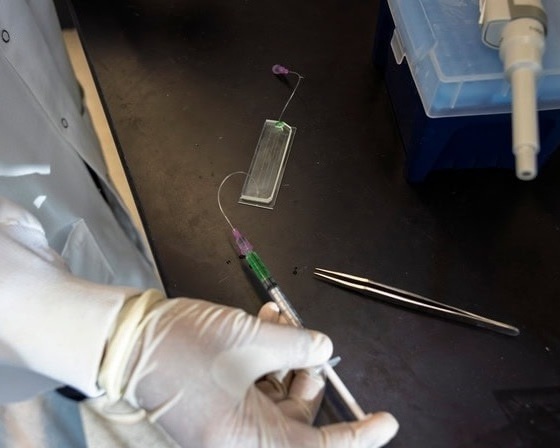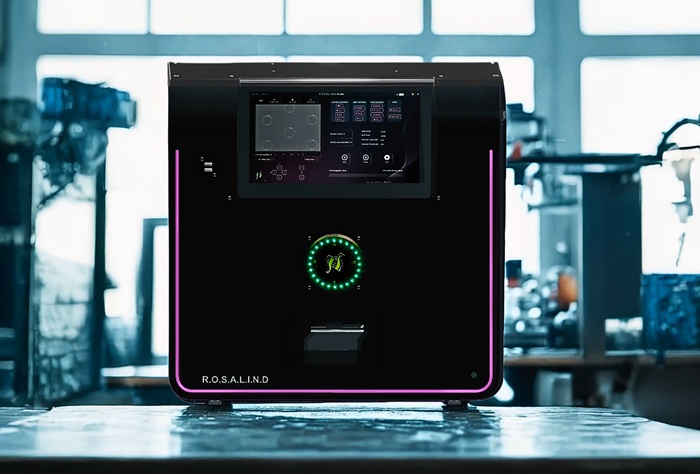Serum Pentosidine Levels Measured in Systemic Lupus Erythematosus
|
By LabMedica International staff writers Posted on 14 Jan 2021 |

Image: Photomicrograph of a section of human skin showing a vacuolar interface dermatitis with dermal mucin. These findings are consistent with discoid skin lesions in lupus dermatitis (Photo courtesy of Nephron).
Systemic lupus erythematosus (SLE), is the most common type of lupus. SLE is an autoimmune disease in which the immune system attacks its own tissues, causing widespread inflammation and tissue damage in the affected organs. It can affect the joints, skin, brain, lungs, kidneys, and blood vessels.
Inflammation causes oxidative stress and favors protein, lipid and nuclear acids glycation creating products collectively denominated as Advanced Glycation Products (AGEs). Glycation is a non-enzymatic protein modification that occurs in situations of hyper and normal glycaemia being accelerated in the first situation. One of the members of the AGE family is pentosidine that results from the reaction of pentoses with free amino groups such as arginine and lysine.
Medical Scientists at the Mackenzie Evangelical School of Medicine Paraná (Paraná, Brazil) carried out a cross sectional study that included 79 patients that fulfilled at least four of the Classification Criteria for Systemic Lupus Erythematosus (SLE) from Systemic Lupus International Collaborating Clinics (SLICC). Five mL of venous blood was obtained from peripheral vein, aliquoted and stored to −80 °C until pentosidine was measured. At the time of blood collection, ESR (erythrocyte sedimentation rate, C reactive protein (CRP), disease activity by the Safety of Estrogen in Lupus National Assessment Systemic Lupus Erythematosus Disease Activity Index (SELENA-SLEDAI) and cumulative damage were measured. Serum pentosidine levels were measured by commercial ELISA kits (XpressBio, Frederick, MD, USA).
The team reported that that there was no evidence that age, gender and ethnic background impact serum pentosidine levels although lower levels of serum pentosidine were seen in older individuals. Levels of pentosidine did not correlate with patients’ ESR and CRP levels, proteinuria, C3 levels. They also did not observe change in pentosidine levels if the patient had active nephritis at time of blood collection or not. Patients with discoid skin lesions and photosensitivity had lower levels than those without them. In the 79 studied patients, the SLEDAI ranged from 0 to 12 (median of 0) and the SLICC/ACR-DI from 0 to 4 (median of 0). Serum pentosidine levels did not correlate with SLEDAI neither with SLICC.
The authors noted that SLE is a disease where inflammation biomarkers are difficult to interpret. C reactive protein, one of the most commonly used inflammatory indicators is usually low in active lupus and one of the given explanations is that patients with this disease can develop autoantibodies against it. A similar process could have happened with pentosidine. The authors concluded that pentosidine levels did not correlate with disease activity or cumulative damage in lupus. Further studies are needed to understand the role of this biomarker in skin manifestations of SLE. The study was published in the January, 2021 issue of the journal Practical Laboratory Medicine.
Related Links:
Mackenzie Evangelical School of Medicine Paraná
XpressBio
Inflammation causes oxidative stress and favors protein, lipid and nuclear acids glycation creating products collectively denominated as Advanced Glycation Products (AGEs). Glycation is a non-enzymatic protein modification that occurs in situations of hyper and normal glycaemia being accelerated in the first situation. One of the members of the AGE family is pentosidine that results from the reaction of pentoses with free amino groups such as arginine and lysine.
Medical Scientists at the Mackenzie Evangelical School of Medicine Paraná (Paraná, Brazil) carried out a cross sectional study that included 79 patients that fulfilled at least four of the Classification Criteria for Systemic Lupus Erythematosus (SLE) from Systemic Lupus International Collaborating Clinics (SLICC). Five mL of venous blood was obtained from peripheral vein, aliquoted and stored to −80 °C until pentosidine was measured. At the time of blood collection, ESR (erythrocyte sedimentation rate, C reactive protein (CRP), disease activity by the Safety of Estrogen in Lupus National Assessment Systemic Lupus Erythematosus Disease Activity Index (SELENA-SLEDAI) and cumulative damage were measured. Serum pentosidine levels were measured by commercial ELISA kits (XpressBio, Frederick, MD, USA).
The team reported that that there was no evidence that age, gender and ethnic background impact serum pentosidine levels although lower levels of serum pentosidine were seen in older individuals. Levels of pentosidine did not correlate with patients’ ESR and CRP levels, proteinuria, C3 levels. They also did not observe change in pentosidine levels if the patient had active nephritis at time of blood collection or not. Patients with discoid skin lesions and photosensitivity had lower levels than those without them. In the 79 studied patients, the SLEDAI ranged from 0 to 12 (median of 0) and the SLICC/ACR-DI from 0 to 4 (median of 0). Serum pentosidine levels did not correlate with SLEDAI neither with SLICC.
The authors noted that SLE is a disease where inflammation biomarkers are difficult to interpret. C reactive protein, one of the most commonly used inflammatory indicators is usually low in active lupus and one of the given explanations is that patients with this disease can develop autoantibodies against it. A similar process could have happened with pentosidine. The authors concluded that pentosidine levels did not correlate with disease activity or cumulative damage in lupus. Further studies are needed to understand the role of this biomarker in skin manifestations of SLE. The study was published in the January, 2021 issue of the journal Practical Laboratory Medicine.
Related Links:
Mackenzie Evangelical School of Medicine Paraná
XpressBio
Latest Clinical Chem. News
- Noninvasive Blood-Glucose Monitoring to Replace Finger Pricks for Diabetics
- POC Breath Diagnostic System to Detect Pneumonia-Causing Pathogens
- Online Tool Detects Drug Exposure Directly from Patient Samples
- Chemical Imaging Probe Could Track and Treat Prostate Cancer
- Mismatch Between Two Common Kidney Function Tests Indicates Serious Health Problems
- VOCs Show Promise for Early Multi-Cancer Detection
- Portable Raman Spectroscopy Offers Cost-Effective Kidney Disease Diagnosis at POC
- Gold Nanoparticles to Improve Accuracy of Ovarian Cancer Diagnosis
- Simultaneous Cell Isolation Technology Improves Cancer Diagnostic Accuracy
- Simple Non-Invasive Hair-Based Test Could Speed ALS Diagnosis
- Paper Strip Saliva Test Detects Elevated Uric Acid Levels Without Blood Draws
- Prostate Cancer Markers Based on Chemical Make-Up of Calcifications to Speed Up Detection
- Breath Test Could Help Detect Blood Cancers
- ML-Powered Gas Sensors to Detect Pathogens and AMR at POC
- Saliva-Based Cancer Detection Technology Eliminates Need for Complex Sample Preparation
- Skin Swabs Could Detect Parkinson’s Years Before Symptoms Appear
Channels
Molecular Diagnostics
view channel
Endometriosis Blood Test Could Replace Invasive Laparoscopic Diagnosis
Endometriosis affects an estimated 1 in 10 women globally, yet diagnosis can take 7 to 10 years on average due to the invasive nature of laparoscopy and lack of accurate, non-invasive tests.... Read more
World's First NGS-Based Diagnostic Platform Fully Automates Sample-To-Result Process Within Single Device
Rapid point-of-need diagnostics are of critical need, especially in the areas of infectious disease and cancer testing and monitoring. Now, a direct-from-specimen platform that performs genomic analysis... Read more
Rapid Diagnostic Breakthrough Simultaneously Detects Resistance and Virulence in Klebsiella Pneumoniae
Antibiotic resistance is a steadily escalating threat to global healthcare, making common infections harder to treat and increasing the risk of severe complications. One of the most concerning pathogens... Read moreHematology
view channel
MRD Tests Could Predict Survival in Leukemia Patients
Acute myeloid leukemia is an aggressive blood cancer that disrupts normal blood cell production and often relapses even after intensive treatment. Clinicians currently lack early, reliable markers to predict... Read more
Platelet Activity Blood Test in Middle Age Could Identify Early Alzheimer’s Risk
Early detection of Alzheimer’s disease remains one of the biggest unmet needs in neurology, particularly because the biological changes underlying the disorder begin decades before memory symptoms appear.... Read more
Microvesicles Measurement Could Detect Vascular Injury in Sickle Cell Disease Patients
Assessing disease severity in sickle cell disease (SCD) remains challenging, especially when trying to predict hemolysis, vascular injury, and risk of complications such as vaso-occlusive crises.... Read more
ADLM’s New Coagulation Testing Guidance to Improve Care for Patients on Blood Thinners
Direct oral anticoagulants (DOACs) are one of the most common types of blood thinners. Patients take them to prevent a host of complications that could arise from blood clotting, including stroke, deep... Read moreImmunology
view channel
Ultrasensitive Liquid Biopsy Demonstrates Efficacy in Predicting Immunotherapy Response
Immunotherapy has transformed cancer treatment, but only a small proportion of patients experience lasting benefit, with response rates often remaining between 10% and 20%. Clinicians currently lack reliable... Read more
Blood Test Could Identify Colon Cancer Patients to Benefit from NSAIDs
Colon cancer remains a major cause of cancer-related illness, with many patients facing relapse even after surgery and chemotherapy. Up to 40% of people with stage III disease experience recurrence, highlighting... Read moreMicrobiology
view channel
New UTI Diagnosis Method Delivers Antibiotic Resistance Results 24 Hours Earlier
Urinary tract infections affect around 152 million people every year, making them one of the most common bacterial infections worldwide. In routine medical practice, diagnosis often relies on rapid urine... Read more
Breakthroughs in Microbial Analysis to Enhance Disease Prediction
Microorganisms shape human health, ecosystems, and the planet’s climate, yet identifying them and understanding how they are related remains a major scientific challenge. Even with modern DNA sequencing,... Read morePathology
view channel
AI Tool Simultaneously Identifies Genetic Mutations and Disease Type
Interpreting genetic test results remains a major challenge in modern medicine, particularly for rare and complex diseases. While existing tools can indicate whether a genetic mutation is harmful, they... Read more
Rapid Low-Cost Tests Can Prevent Child Deaths from Contaminated Medicinal Syrups
Medicinal syrups contaminated with toxic chemicals have caused the deaths of hundreds of children worldwide, exposing a critical gap in how these products are tested before reaching patients.... Read more
Tumor Signals in Saliva and Blood Enable Non-Invasive Monitoring of Head and Neck Cancer
Head and neck cancers are among the most aggressive malignancies worldwide, with nearly 900,000 new cases diagnosed each year. Monitoring these cancers for recurrence or relapse typically relies on tissue... Read moreTechnology
view channel
Diagnostic Chip Monitors Chemotherapy Effectiveness for Brain Cancer
Glioblastoma is one of the most aggressive and fatal brain cancers, with most patients surviving less than two years after diagnosis. Treatment is particularly challenging because the tumor infiltrates... Read more
Machine Learning Models Diagnose ALS Earlier Through Blood Biomarkers
Amyotrophic lateral sclerosis (ALS) is a rapidly progressive neurodegenerative disease that is notoriously difficult to diagnose in its early stages. Early symptoms often overlap with other neurological... Read moreIndustry
view channel
BD and Penn Institute Collaborate to Advance Immunotherapy through Flow Cytometry
BD (Becton, Dickinson and Company, Franklin Lakes, NJ, USA) has entered into a strategic collaboration with the Institute for Immunology and Immune Health (I3H, Philadelphia, PA, USA) at the University... Read more




















